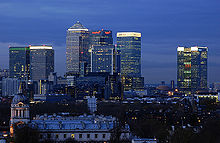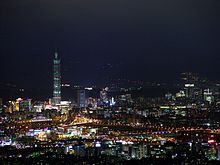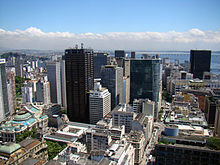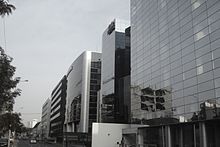- Central business district
-
"City center" redirects here. For other uses, see City Center (disambiguation).
 The central business district of Toronto, Canada
The central business district of Toronto, Canada
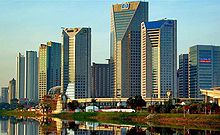 Sao Paulo, the largest city in Brazil.
Sao Paulo, the largest city in Brazil.
A central business district (CBD, also called a central activities district) is the commercial and often geographic heart of a city.[citation needed] In North America this part of a city is commonly referred to as "downtown" or "city center".[citation needed] "City centre" is commonly used in Britain, Ireland and Canada.
Contents
Overview
The term CBD or Central Business District is the central district of a city, usually typified by a concentration of retail and office buildings.[1]
The term city place is similar to CBD in that both serve the same purpose for the city, and both are marked by a higher-than-usual urban density as well as often having the tallest buildings in a city. City centre differs from downtown in that the latter can be geographically located anywhere in a city, while a city centre is generally located near the geographic heart of the city. London arguably has three city centres, the City of London, the medieval City of Westminster and the transformed Docklands area. Mexico City also has more than one city centre: Centro Histórico, the colonial; Paseo de la Reforma - Polanco (Mexico) the mid-late 20th century CBD, and Santa Fe, the new CBD. In Taipei, Taiwan, the area around its main railway station is regarded as the historic city centre while the Xinyi Planned Area located to the east of the said railway station is the current CBD of Taipei and not only is it considered the financial district of Taipei, but it is arguably the premier shopping area in Taipei and Taipei's most modern cosmopolitan district. Taipei 101, Taipei's tallest building and currently the world's second tallest habitable skyscraper, is located in Xinyi Planned Area.
The shape and type of a CBD or downtown almost always closely reflect the city's history. Cities with maximum building height restrictions often have a separate historic section quite apart from the financial and administrative district. In cities that grew up suddenly and more recently, such as those in the western half of North America, a single central area will often contain all the tallest buildings. It has been said that downtowns (as understood in North America) are therefore a separate phenomenon.[2]
Central business districts usually have very small resident populations. For example, the population of the City of London declined from over 200,000 in the year 1700 to less than 10,000 today. In some instances, however (and particularly in large Australian and Canadian cities), CBD populations are increasing as younger professional and business workers move into city centre apartments.
Usage
The alternative term city centre is used in Britain and Ireland, and also in some urban areas of British-influenced countries, such as the Commonwealth and Mainland China (Chinese: 市中心), or the equivalent city center in some Rocky Mountain cities such as Salt Lake City or Cheyenne in the United States. In the United Kingdom, Australia, South Africa, Canada and New Zealand, the term is often just shortened to "city", as in "going to the city". This term is also used in the New York City area in the same manner, using the term the city to mean Manhattan. Similarly, San Francisco is referred to as "the City" in the Bay Area. One exception is in London where "the City" specifically refers to the City of London financial district rather than to any other part of Central London. In many parts of the world, including the UK, Australia, New Zealand, South Africa, India (especially Mumbai, where CBD is also known as "Townside") and Ireland, it is often also referred to as "town" ("going (in)to town", "going up town", or "going down town").
Australia
The term is used to refer to the business and financial area of a state capital city such as the Sydney CBD, Melbourne CBD, Brisbane CBD, Perth CBD and Adelaide CBD.
Argentina
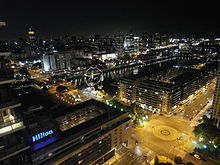 Puerto Madero, Buenos Aires CBD
Puerto Madero, Buenos Aires CBD
The Buenos Aires central business district (CBD and also referred to as the City Porteña), is the main commercial centre of Buenos Aires, the capital of Argentina. The actual area was the point of first European settlement. Its north-south axis runs from Monserrat in the north to Retiro railway station in the south. Its east-west axis runs from Buenos Aires Ecological Reserve and Puerto Madero.
The district is the financial, commercial, and cultural hub of Argentina. Its port is one of the busiest in South America; navigable rivers by way of the Río de la Plata connect the port to north-east Argentina, Brazil, Uruguay and Paraguay. As a result it serves as the distribution hub for a vast area of the south-eastern region of the South American continent. Tax collection related to the port has caused many political problems in the past. Measured in GDP, the economy of Buenos Aires was the 13th largest economy among the world's cities in 2005 at US$245 billion in purchasing power parity, which, based on the population of that year, translates into US$19,500 per capita. The Buenos Aires Human Development Index (0.923 in 1998) is likewise high by international standards.
The city's services sector is diversified and well-developed by international standards and accounts for 78% of its economy (compared to 58% for all of Argentina's); advertising, in particular, plays a prominent role in the export of services at home and abroad. Manufacturing is, nevertheless, still prominent in the city's economy (17%) and, concentrated mainly in the southside, it benefits as much from high local purchasing power and a large local supply of skilled labor as it does from its relationship to massive agriculture and industry just outside the city limits themselves.
Brazil
The Sao Paulo central business district is the Avenida Paulista, in the region close to the city centre, which is also a financial centre, but has the same influence of decades ago. However, there are other central outside the geographical core, as the districts of Santo Amaro and Itaim Bibi, more precisely the regions of Juscelino Kubitschek, Luís Carlos Berrini and Faria Lima avenues, in southwest-central city, which are characterised by intense vertical, and the presence of luxury hotels and multinational companies.
The biggest financial centre in Brazil and one of the biggest finacional centres in the world, Sao Paulo's economy is going through a deep transformation. Once a city with a strong industrial character, São Paulo's economy has become increasingly based on the tertiary sector, focusing on services and businesses for the country. Although being the most important financial centre of the country, Sao Paulo also presents a high degree of informality in its economy.
Rio de Janeiro downtown remains the heart of the city's business community, and the second largest in South America. Some of the largest companies in Brazil have their head offices here, including Petrobras, Eletrobrás and Vale (formerly Companhia Vale do Rio Doce), three of the largest Brazilian corporations.
Germany
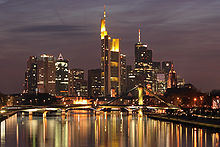 Central business district of Frankfurt, Germany.
Central business district of Frankfurt, Germany.
In Germany the terms Innenstadt and Stadtzentrum may be used to describe the central business district. Both terms can be literally translated to mean "inner city" and "city centre". Some of the larger cities have more than one central business district, like Berlin which has three. Due to Berlin's history of division during the Cold War, the city contains central business districts both in West Kurfürstendamm and East Berlin (Alexanderplatz), as well as a newly built business centre near Potsdamer Platz. The city's historic centre, location of the Reichstag building as well as the Brandenburg gate and most federal ministries was largely abandoned when the Berlin Wall cut through the area. Only after the reunification with the construction of numerous shopping centres, government ministries, embassies, office buildings and entertainment venues, was the area revived. In Frankfurt there is a business district which is in the geographical centre of the city and is called the Bankenviertel.
India
India uses the term Central Block District to describe CBD Belapur, which has a fairly vibrant Central Business District that is moving some of the economy out of congested central Mumbai into the hinterland. Belapur is also one of the largest assembly constituencies from this region. CBD Belapur has been growing since the 1990s, and is now home to colleges as well as a number of technology businesses. It was designed and developed in order to promote businesses. The Reserve Bank of India maintains a branch office at CBD Belapur. This area is one of the fastest developing region in Navi Mumbai in terms of new residential and commercial construction projects.
Pakistan
 View of Karachi's skyline from the I.I. Chundrigar Road
View of Karachi's skyline from the I.I. Chundrigar Road
In Pakistan, a central business district or a large, concentrated urban setting within a settlement is called a shehar. Karachi is Pakistan's largest city and the country's economic hub; the Ibrahim Ismail Chundrigar Road of the city, often called the "Wall Street of Pakistan," acts as Karachi's main financial district and is essentially a center of economic and industrial activity. Santa Fe, CBD in Mexico City
Peru
In Peru the central business district is San Isidro, in Lima, which hosts the majority of Peru's financial industry headquarters.[3] Although still a largely residential district, the commercial and business activity located in or in the vicinity of the area defined by avenues Camino Real, Javier Prado Este, República de Panamá and Aramburú is highly regarded as Peru's financial and corporate heart.[4][5] It has a permanent population of around 63,000 inhabitants[6] and, during weekday business hours, a floating population that exceeds 700,000 daily commuters from other districts of Lima.[7] San Isidro is served by three stations of El Metropolitano, Lima's bus rapid transit system: Estación Javier Prado, Estación Canaval y Moreyra (with over 16,000 daily passengers)[8][9] and Estación Aramburú.
Since the late 2000s the southeastern district of Surco[10] has experienced a significant increase in upscale corporate developments in the area comprised by avenues Manuel Holguín, El Derby, El Polo and La Encalada due to lower restrictions to grant construction licences and proximity to residential middle and upper class districts and is set to become, after traditional San Isidro and Miraflores, the new corporate center of Lima.[11]
Poland
In Poland, the terms Śródmieście may be used to describe the central business district. In many of the largest Polish cities, however, śródmieście refers to an historic district rather than a business district, or it may not be used at all.
South Africa
South African cities like Cape Town and Johannesburg have three CBDs while cities like Durban and Port Elizabeth have only one. Cape Town is known for having South Africa's most iconic skyline (including the famous Table Mountain) and CBD.[12]
Francophonie
In France and French-speaking regions, the most common term for a city's centre is centre-ville (town centre). In many of the largest francophone cities, however, centre-ville refers to an historic district rather than a business district, or it may not be used at all.
In Paris, the main business district is in La Défense, distant from the geographical centre of the city, on the western edge of the boundaries of the Paris commune (municipality). The historic centre of Brussels is bounded by the inner ring road. However, the financial and administrative district is the Leopold Quarter. Montreal's historic core, Old Montreal, is no longer the financial district, which is now Downtown Montreal.
Some francophone cities use centre-ville to refer to the CBD. In Beirut, for example, although the CBD is officially called Beirut Central District, the Lebanese use the French term centre-ville.
United States and Canada
Main article: Downtown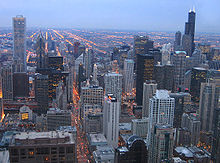 The central business district of Chicago, called The Loop.
The central business district of Chicago, called The Loop.
In the United States and Canada, central business districts are often referred to as "downtown" (even if there is no "uptown"). In most cities the downtown area will be home to the financial district, but usually contains entertainment and retail of some kind as well. The downtown areas of many cities, such as Chicago, New Orleans and Houston, are also home to large sports and convention venues. Historic sections of a central business district may be referred to as "old town", while decaying parts of the centre city are commonly referred to as the "inner city". The term inner city is sometimes not used literally but rather evocatively, applying a negative connotation and referring paradoxically to peripheral areas blighted during a mass exodus of middle class residents.
Some cities in the United States, such as Minneapolis, and Dallas, have mixed use districts known as "uptown" in addition to the primary downtown core areas. In some cities, such as Charlotte, North Carolina, Chicago, Illinois and Oklahoma City, "uptown" is instead the historic name for a separate business centre or neighbourhood. Philadelphia and Wilmington, Delaware use the term center city instead of downtown for their central business districts. In Canada, "city centre" is used, more or less, as a synonym for "downtown". Some cities, such as Toronto, regard as many as four business districts as being central. In other cities, like Los Angeles and Indianapolis, the city core is simply known as "downtown". In New Orleans, the phrase Central Business District is used; and while downtown is sometimes used synonymously, traditionally it referred to parts of the city downriver from Canal Street, which would not include the CBD. One exception is the population in Seattle, local residents refer to the center of the city as the CBD. In Miami, "Downtown Miami" refers to the neighborhoods (such as Brickell and Omni) within the city center, not just the central business district.
By broad definition, New York City's CBD comprises the whole southern half or third of Manhattan island.[citation needed] Narrow definitions include only a square mile or two (3–5 km²) of Midtown as central, with the lowest tenth of the island, including the Financial District, being a secondary business district rather than the central one.[citation needed] Similar narrow and broad definitions are applied to the Chicago's downtown high rise districts.[citation needed]
Land value variations in a CBD
Land users, whether they be retail; office; or residential, all compete for the most accessible land within the CBD. The amount they are willing to pay is called bid rent. This can generally be shown in a ‘bid rent curve’. Based upon the reasoning that the more accessible the land, generally in the centre, is the more expensive land.
This is called the bid rent theory.
Commerce (especially large department stores/chain stores) is willing to pay the greatest rent to be located in the inner core. The inner core is very valuable for them because it is traditionally the most accessible location for a large population. This large population is essential for department stores, which require a considerable turnover. As a result, they are willing and able to pay a very high land rent value. They maximise the potential of their site by building many stories.
As one moves from the inner core, the amount commerce is willing to pay declines rapidly. Industry, however, is willing to pay to be in the outer core. There is more land available for their factories, but they still have many of the benefits of the inner core, such as a market place and good communications.
As one moves farther out, so the land is less attractive to industry due to the reducing communication links and a decreasing market place. Because the householder does not rely heavily on these and can now afford the reduced costs (when compared with the inner and outer core) is able to purchase land.
The farther one goes from the inner core and outer core, the cheaper the land. That is why inner city areas are very densely populated (terraces, flats and highrises), whilst the suburbs and rural areas are sparsely populated (semi and detached houses with gardens).
Secondary Central business district
is a small business district developing close to the central business district. Examples include the Canary Wharf financial district in London, which functions as the secondary financial heart of the city.
See also
- List of central business districts
- Business Improvement District
References
- ^ Central Business District (from scalloway.org.uk website)
- ^ Reviving American downtowns - The Economist, Thursday 1 March 2007
- ^ General information of San Isidro (in Spanish) retrieved from San Isidro's Municipality official website www.msi.gob.pe on 2011-09-04
- ^ San Isidro - Peru retrieved from AboutPeruhistory.com on 2011-09-04
- ^ History of San Isidro, Lima, Peru retrieved from SanIsidroPeru.com on 2011-09-04
- ^ San Isidro - Population - Municipality of San Isidro website (in Spanish) retrieved from San Isidro's Municipality official website www.msi.gob.pe on 2011-09-04
- ^ Mayor of San Isidro proposes alternatives to mitigate San Isidro's challenges (in Spanish) retrieved from LaRepublica.pe on 2011-09-04
- ^ Metropolitano's Canaval y Moreyra station will have a new access for passengers (in Spanish) retrieved from El Comercio.pe on 2011-08-22
- ^ Canaval y Moreyra station will have a new access for passengers (in Spanish) retrieved from Peru21.pe on 2011-08-23
- ^ Municipality of Santiago de Surco - official website (in Spanish) retrieved on 2011-09-16
- ^ Surco, the new corporate center in Lima(in Spanish) retrieved from AlfredoGraf.com on 2011-09-04
- ^ "http://www.new7wonders.com/community/en/new7wonders/new7wonders_of_nature/table_mountain" - "New 7 Wonders" of the World website, Wednesday 6 October 2010
Categories:- Central business districts
- City
- Neighborhoods
Wikimedia Foundation. 2010.

